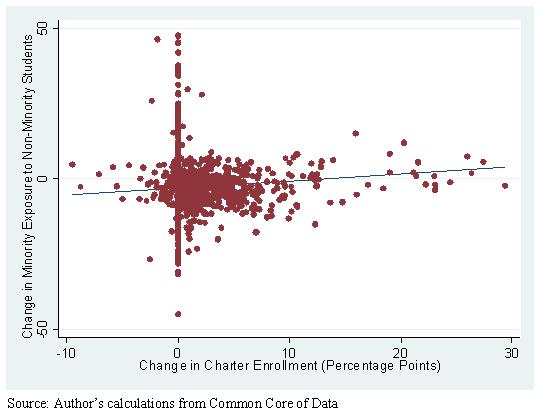...I provide new evidence on this question based on an analysis of nine years of data from the Common Core of Data, the federal government’s annual census of all public schools. For each of the more than 3,000 counties in the U.S., I calculate an “exposure index” that measures the share of non-minority students at the schools attended by the average under-represented minority student.[2] The average minority student in the U.S. attends a school that is 33 percent non-minority. In other words, the typical minority student attends a majority-minority school. Likewise, the typical student eligible for free or reduced-price lunch (a proxy for economic disadvantage) attends a school where almost two-thirds of students are also eligible for a subsidized lunch.
A naïve examination of the relationship between this measure of (de)segregation and the percentage of students enrolled in charter schools appears to show that the critics are right: more choice is associated with minority students attending less diverse schools. For the 2010-11 school year, a 10-percentage-point increase in charter enrollment is associated with a decline of 16 percentage points in minority students’ exposure to non-minority students. A similar but weaker relationship exists along class lines (as measured by free lunch eligibility).
Of course, this relationship ignores the fact that charters tend to locate in areas that serve large shares of disadvantaged students and members of minority groups. As a result, this simple correlation tells us nothing about whether charters increase segregation or just tend to locate in areas where the schools are already segregated. This is the same methodological flaw that compromised the findings of the UCLA study.
A better approach to the question of whether choice increases segregation is to look at changes over time. Did areas that saw large increases in choice experience larger increases in segregation than areas that saw smaller increases in choice? This kind of analysis does not conclusively measure the causal effect of choice on segregation, but by examining the same locales over time it represents a clear improvement over the cruder approach of comparing different locales at the same point in time. For example, it takes into account any unmeasured factors, such as the degree of residential segregation, to the extent that those factors remain constant over time.
Figure 1 shows the relationship between the change in charter enrollment and the change in minority exposure to non-minority students between 2002-03 and 2010-11.[3] The cloud of points suggests little relationship between these two factors, and a regression analysis confirms that this is the case.[4] There is actually a slight positive (and statistically significant) relationship between choice and diversity, but it is very weak and is not also found in the free-lunch data.
I also used an alternative measure of segregation called a “dissimilarity index” and obtained similar findings: no consistent relationship between changes in charter enrollment and changes in segregation. Finally, I conducted a more sophisticated panel data analysis that uses all nine years of data to estimate the relationship between charter enrollment and segregation using only the changes within counties over time.[5] Once again, using both the exposure and dissimilarity indices, the results consistently indicated no meaningful relationship between choice and segregation.
The lack of any consistent relationship between charter enrollment and segregation does not eliminate the possibility that such a relationship exists, but suggests that it is unlikely. For there to be a relationship, it would have to be the case that counties where charter enrollment increased experienced an increase in segregation as a result but then adopted policies (or experienced other changes) that counteracted the increase in segregation. In my view, that is not a very plausible explanation for these results.
Saturday, October 01, 2016
Does Expanding School Choice Increase Segregation? | Brookings Institution
Does Expanding School Choice Increase Segregation? | Brookings Institution
Subscribe to:
Post Comments (Atom)

No comments:
Post a Comment